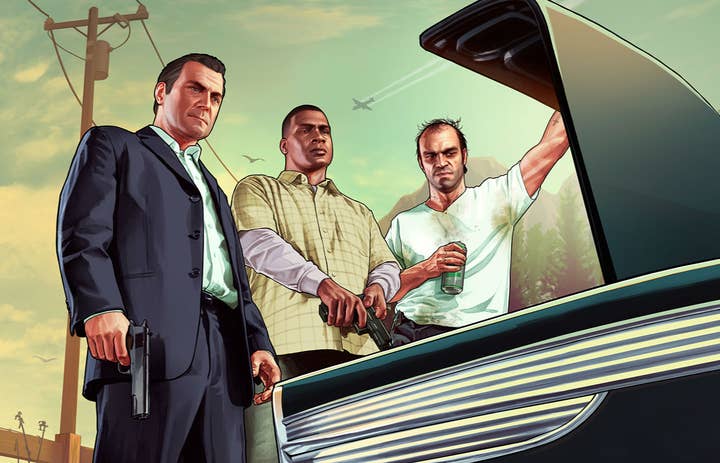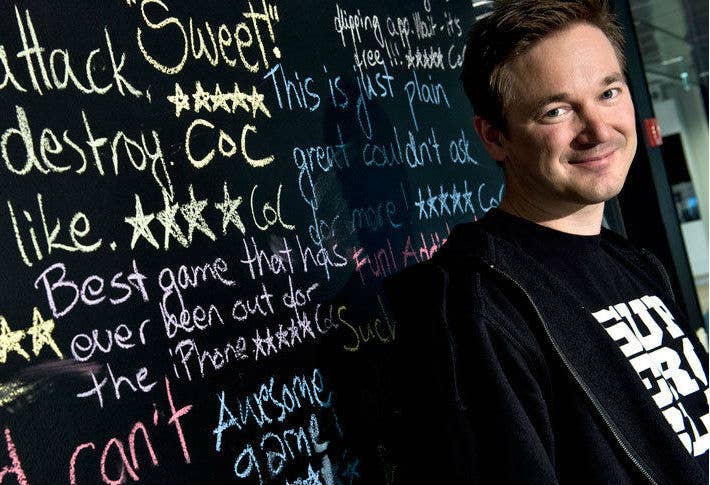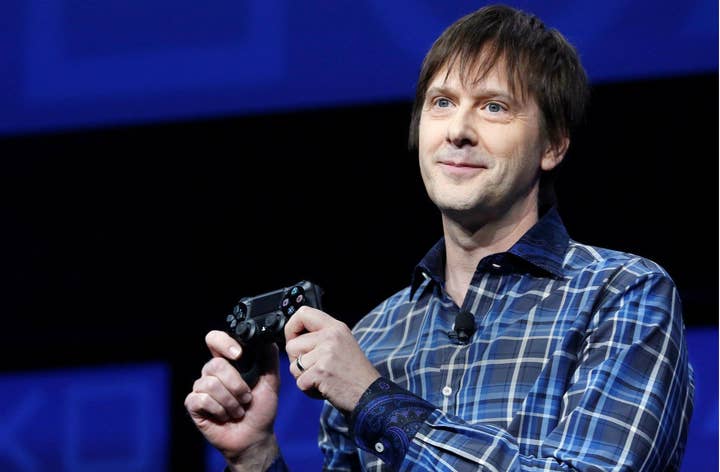Persons of the Year: The Class of 2013 pt. 2
Crowdfunding, billion-dollar deals and a bit of the old ultra-violence, but who's number one?
Here we are, the five most important people in the games industry of 2013 (be sure to read Part 1 first if you haven't). This is where the really hard decisions are taken, and where the most impassioned debate will start. Those who make it this far are the outliers: the most skilled, the most influential and the most powerful individuals working in the games business, forging ahead - and coming undone - in both established and emerging markets.
But there can only be one true winner, and while any of the people listed below could lay a convincing claim to the number one spot, this year there was little debate on the GamesIndustry International team as to whom that accolade truly belonged. You might see it our way or you might disagree, and we're fine with that - this is the internet, after all.
5. Chris Roberts, Cloud Imperium Games
Forget Double Fine Adventure, forget Torment and forget Project Eternity. If you want to see the true potential of crowd-funding, look no further than Star Citizen

Talk about making an entrance. After an eight-year period in which he largely focused on movies, Chris Roberts signalled his return to the games industry in late 2012 with the announcement of Star Citizen, an ambitious space sim in the spirit of his classic Wing Commander series. Crowdfunding had been one of the defining trends of that year, and Star Citizen was yet another example of its potential, raising more than $6 million in five weeks.
But what Roberts and his team at Cloud Imperium have accomplished this year - even in the last six months - is orders of magnitude more impressive. In June, Star Citizen's total pledges had reached $10 million, in September $20 million, in October $25 million. At the last count, just a few days ago, Cloud Imperium had secured $33 million from its community, putting Roberts firmly back in AAA territory without the need to answer to a AAA publisher. Forget Double Fine Adventure, forget Torment and forget Project Eternity. If you want to see the true potential of crowdfunding, look no further than Star Citizen.
"I never expected to able to fully fund a game of the ambition of Star Citizen with just crowdfunding," Roberts told GamesIndustry International, admitting that he had originally set a $14 million target just to complete a "compelling" alpha version. "But after the record breaking initial campaign came to a close, the money and backers continue to flow in and we realized there was an opportunity to become the first 100% crowdfunded AAA game."
The scale of public support has allowed Cloud Imperium to assemble a far bigger team than Roberts ever imagined, and freed it of the need to hit "arbitrary deadlines" to satisfy the standards imposed by publishing executives. "But I don't think it's too different than my past games in terms of personal pressure," Roberts said. "I'm always my own biggest critic. I'm building Star Citizen for me as much as anyone and I don't want to waste this incredible opportunity by doing something that isn't great. What's nice is that there are almost no external agendas that could interfere with that goal.
"It's good for the gamer as they have their voice respected. Too often they feel like they are force fed the same game year after year... I don't want Star Citizen to be an exception to the rule. I want other great development teams to be able to experience the new kind of creative freedom that I have with this project. Hopefully if Cloud Imperium Games and some of the other higher profile crowdfunded games live up to our stated goals, I think people will become increasingly comfortable backing similar projects in the future."
4. Don Mattrick, Zynga
There is a pleasing symmetry to the industry's most beleaguered executive joining one of the industry's most beleaguered developers

When Sony Computer Entertainment sends out its Christmas cards this year, Don Mattrick's name should really be one of the first on the list. The way that Sony has surged ahead in the early stages of the generation - in perception, if not exactly in numbers - is down to strong hardware and consistent messaging, of course, but it's important to remember that, at the start of the year, it looked like Microsoft's race to lose. Only through a series of baffling and forensically documented blunders was Sony able to take the initiative, most famously at this year's E3, when the crowd only just stopped short of hoisting Jack Tretton onto its shoulders and performing a victory lap.
Can all of those poor decisions really be the fault of just one person? In reality, probably not, but the buck has to stop somewhere, and Don Mattrick was king of the hill at Xbox. Certainly, there was plenty of evidence to indicate that he was less than pleased with the public reaction to the Xbox One's strategy, specifically an interview in which he dismissed concerns about the divisive always-on requirement, and a blog post ostensibly describing important amendments to underlying policies that seemed just as concerned with explaining why Microsoft's original ideas were so misunderstood. The phrase "gracious in defeat" did not leap to mind.
So when Mattrick made the leap to Zynga it was hard not to take the news as a positive step for the Xbox One. But there is a pleasing symmetry to the industry's most beleaguered executive joining one of the industry's most beleaguered developers, and it would be rash to assume that Mattrick couldn't drastically improve Zynga's performance - just consider the remarkable progress made by the Xbox 360 on his watch.
Don Mattrick could have made this list twice in 2013, and if Zynga has half the potential he thinks it does, you can expect to see his name here again very soon.
3. Sam & Dan Houser, Rockstar Games
With Rockstar, one gets the sense that there is method supporting every last bit of the madness, no matter how confrontational and amoral it appears at first

Annualised franchises have become such a common feature of the blockbuster release schedule that a game like Grand Theft Auto V - strutting into view a full five years after its predecessor - can seem like an oasis of original thinking. To be fair, the fifth game in Rockstar's vital series didn't exactly rip up its own foundations, but the switch to multiple protagonists is as inspired a creative decision as GTA has seen since its transition to 3D graphics. Suddenly, the series' anarchic rampages were given a proper place to exist, as was its cynicism, as was its heart.
Rockstar is often criticised for its callous representations of violence and gender - and those complaints are not without merit - but an experience as impeccably detailed and sharply observed as Grand Theft Auto V arguably belongs in a different conversation to the average stereotype shooting-gallery. With Rockstar, one gets the sense that there is method supporting every last bit of the madness, no matter how confrontational and amoral it appears at first. There is a vision at work here; an aesthetic and thematic sense that unites Rockstar's games as a body of work. Precious few developers working at this scale can make such a claim.
And then there's the money. Nobody expected Grand Theft Auto V to crash and burn, exactly, but few would have predicted the sheer size of the numbers. The final proof arrived nearly two months after Rockstar announced record-breaking three-day revenue of $1 billion, in the form of a pointed Activision press release that attempted to spin the performance of Call of Duty: Ghosts into something that could stand comparison to what GTA V had achieved. One can imagine the satisfaction Rockstar's sibling founders took in knocking Activision's crown askew.
2. Ilkka Paananen, Supercell
It takes an awful lot of right choices, careful hiring and conscientious management to create something as popular and enduring as Clash of Clans

Back in 2011, Supercell was busy working on a browser-based action game inelegantly titled Gunshine.net, and it would be no insult to Ilkka Paananen, the company's CEO, if you couldn't recall its exact details. At the start of this year, Supercell was largely known for two products, and two products alone: Hay Day and Clash of Clans, both huge successes on iOS that drove profits for the first quarter of 2013 past $100 million. In April, rumours of a $100 million funding round began to circulate, putting the company's value at close to $800 million.
The fact that $800 million seemed like a reasonable figure speaks volumes for the sort of progress Supercell has made since the days of Gunshine, and Paananen has been there every step of the way, planning for a future that, this year, Supercell finally made reality. When a game starts raking in as much money as Clash of Clans it's tempting to dismiss it as an 'overnight success', but it takes an awful lot of right choices, careful hiring and conscientious management to create something so popular and - judging by Supercell's ongoing supremacy in the top-grossing charts - so enduring.
Softbank's $1.5 billion acquisition of the company in October all but guaranteed Paananen's place on this list. And if the partnership between Supercell and GungHo can yield the sort of results their combined revenues suggest, we might as well reserve his place for 2014 now.
1. Mark Cerny, PlayStation
Long before the first PS4s went on sale, Sony had already seized a majority of the available goodwill from its more didactic rival. That process started with Cerny's ascension to the head of the project

In a year defined by new consoles, someone intimately involved with their creation and release was always likely to emerge as the most influential figure. Hindsight brings clarity, of course, and looking back as we stride towards 2014 it's hard to see past the moment that Mark Cerny took the stage at the PlayStation 4's unveiling in February as the first sign that something in Sony Computer Entertainment had changed. Cerny has always had close ties with Sony, but he is also one of the industry's most revered independents. Yet there he was, describing his philosophy as lead architect of a product that had the potential to change the fortunes of a company in dire need of just that. Cerny is a developer's developer, and his presence on that stage felt like a statement of intent.
"Six years ago, when I started work on the hardware, I had a theory that designing it collaboratively with the development community would result in a much stronger launch and post-launch line-up, and therefore be more appealing to the gamers," he told GamesIndustry International. "I had hopes that this strategy would meet with a warm reception, but I never would have imagined the passionate response and the record breaking sales that we have achieved."
Where the development of the PlayStation 3 was anchored by its complicated Cell processor, Cerny took a more holistic approach to the PlayStation, working towards a "larger user experience" and letting that inform key decisions about the hardware. "The social aspects of the platform, the idea of playing games even as you are downloading them, the redesigned controller... these and many more concepts emerged in the last two years of the design process. It's been very gratifying to see the positive response from gamers to these features."
This adherence to the ease and quality of experience - for both developers and players - made all the difference in pushing PlayStation 4 to its early lead in the nascent console race. Long before the first units went on sale, Sony had already seized a majority of the available goodwill from its more didactic rival. That process started with Cerny's ascension to the head of the project. He admits to being "overwhelmed" by the experience, but where does it stand in the context of his long and storied career?
"I've had a lot of roles," Cerny said. "Sometimes I have been the key driver of the concept and the project; an example would my first big arcade title, Marble Madness. Other times, I've been in a support role, as when I had a chance to work with brilliant creative directors such as Ted Price and Jason Rubin on Ratchet & Clank, Crash Bandicoot, Jak and Daxter, and the like.
"Designing PS4 is in a sense the ultimate support role, about half a decade of my time devoted to making it possible for those game creators to make their next breakthrough title. To answer your question, though, I'd have to put it at the top."

